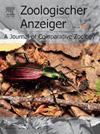Overview of morphology and neuromuscular system of coronate polyps on the example of Linuche sp. (Scyphozoa, Coronatae)
IF 1.5
3区 生物学
Q2 ZOOLOGY
引用次数: 0
Abstract
Jellyfish from the class Scyphozoa have been the subject of numerous studies due to their blooms and impacts on the economy. The polypoid stage plays a main role in the occurrence of blooms, as it forms young medusae during strobilation. Ecological aspects that affect the strobilation has been well studied over the years, while morphological data on polypoid stage is available mainly for model species, such as members of genera Aurelia and Cassiopea. One of the less studied polyps are from the order Coronatae – the basal group of Scyphozoa. In this work, we focused on the morphology of the Linuche sp. coronate polyp.
For the first time, we describe the histological features and general topology of the neuromuscular system of Linuche sp. polyps using confocal laser scanning microscopy and semi-thin sections, also we provide information on the structure of its periderm tube and cusps – important taxonomic characters of coronate polyps – with usage of scanning electron microscopy. Its nervous system is presented as a nerve net in the body column with longitudinal neuron groups accompanying the muscle bands, and two nerve rings in the capitulum, acting as integrative centers. The muscular system in Linuche sp. has a complex organization with numerous groups of muscular processes in the capitulum that are intertwined with the musculature of the body column and tentacles. Comparison of the organization of polyps from Coronatae and Discomedusae revealed significant differences in their anatomy, due to the presence of the periderm tube in coronates.
冠状息肉形态及神经肌肉系统的研究——以冠状动物Linuche sp.为例
由于其大量繁殖和对经济的影响,来自形虫纲的水母一直是许多研究的主题。水螅体阶段在花的发生中起主要作用,因为它在杂交过程中形成年轻的水母。影响水螅期的生态因素已被广泛研究,而水螅期的形态学资料主要是模式物种,如Aurelia属和Cassiopea属的成员。其中一种较少被研究的珊瑚虫来自冠状目——孢子虫的基础群。在这项工作中,我们重点研究了Linuche sp.冠状息肉的形态学。本文首次利用激光共聚焦扫描显微镜和半薄片对Linuche sp. polyps的神经肌肉系统的组织学特征和一般拓扑结构进行了描述,并利用扫描电镜对其周管和尖端的结构进行了研究,这是冠状息肉的重要分类特征。其神经系统表现为体柱内的神经网络,纵神经元群伴发于肌带,小头部有两个神经环作为综合中枢。Linuche sp.的肌肉系统有一个复杂的组织,在小头肌中有许多肌肉过程,这些肌肉过程与体柱和触手的肌肉组织交织在一起。比较冠状科和蝶状科息肉的组织结构,发现它们的解剖结构有显著差异,这是由于冠状科中存在外周管。
本文章由计算机程序翻译,如有差异,请以英文原文为准。
求助全文
约1分钟内获得全文
求助全文
来源期刊

Zoologischer Anzeiger
生物-动物学
CiteScore
2.80
自引率
7.10%
发文量
75
审稿时长
>12 weeks
期刊介绍:
Zoologischer Anzeiger - A Journal of Comparative Zoology is devoted to comparative zoology with a special emphasis on morphology, systematics, biogeography, and evolutionary biology targeting all metazoans, both modern and extinct. We also consider taxonomic submissions addressing a broader systematic and/or evolutionary context. The overall aim of the journal is to contribute to our understanding of the organismic world from an evolutionary perspective.
The journal Zoologischer Anzeiger invites suggestions for special issues. Interested parties may contact one of the editors.
 求助内容:
求助内容: 应助结果提醒方式:
应助结果提醒方式:


